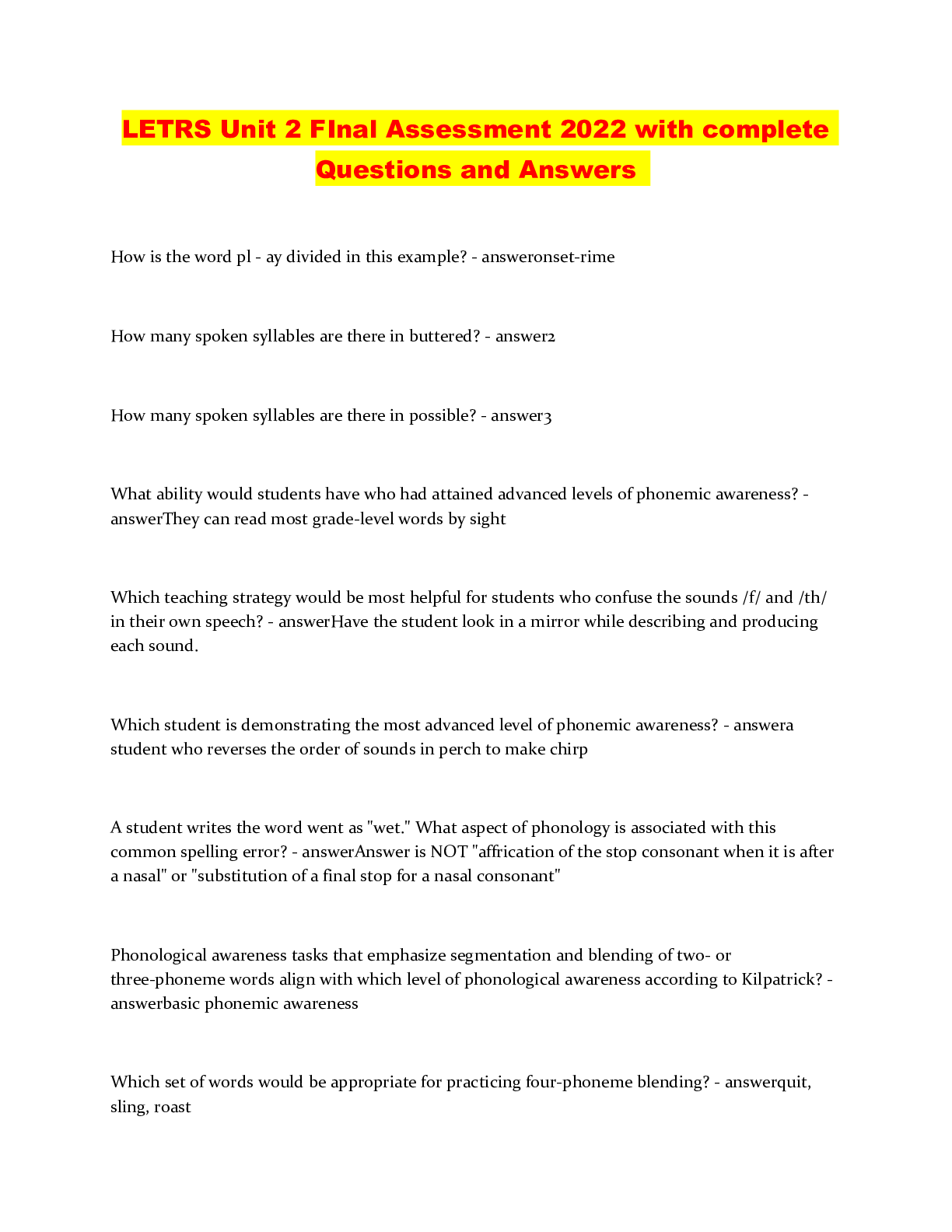Sociology > QUESTIONS & ANSWERS > Final Revision (true & false)& MCQ Operation Management. Chapter 01 - Introduction to Operations Man (All)
Final Revision (true & false)& MCQ Operation Management. Chapter 01 - Introduction to Operations Management, Chapter 02 - Competitiveness, Strategy, and Productivity, Chapter 03 :-Forecasting, Chapter 04 :-Product and Service Design, Chapter 06:-Process Selection and Facilities Layout, Chapter 08:-Location Planning and Analysis,
Document Content and Description Below
True / False Questions 1. Operations managers are responsible for assessing consumer wants and needs and selling and promoting the organization's goods or services. FALSE 2. Often, the collective s... uccess or failure of companies' operations functions will impact the ability of a nation to compete with other nations. TRUE 3. The greater the degree of customer involvement, the more challenging the design and management of operations. TRUE 4. Goods producing organizations are not involved in service activities FALSE 5. The value of outputs is measured by the prices customers are willing to pay for goods or services. TRUE 6. People who work in the field of operations should have skills that include both knowledge and people skills. TRUE 7. The operations manager has primary responsibility for making operations system design decisions, such as system capacity and location of facilities. FALSE 8. The word "technology" is used only to refer to 'information technology'. FALSE 9. Service often requires greater labor content, whereas manufacturing is more capital intensive. TRUE 10. One method of classifying production systems is the degree of standardization. TRUEMultiple Choice Questions 1 Operations management involves continuous decision-making; hopefully most decisions made will be: A. redundant B. minor in nature C. informed D. quantitative E. none of the above 2. A 'product package' consists of: A. the exterior wrapping B. the shipping container C. a combination of goods and services D. goods if a manufacturing organization E. customer relations if a service organization 3. Business organizations consist of three major functions which, ideally: A. support one another B. are mutually exclusive C. exist independently of each other D. function independently of each other E. do not interface with each other 4. Technology choices seldom affect: A. Costs. B. Productivity. C. Union activity. D. Quality. E. Flexibility. 5. Budgeting, analysis of investment proposals, and provision of funds are activities associated with the _______ function. A. operation B. marketing C. purchasing D. finance E. internal audit 6. Which one of the following would not generally be classified under the heading of transformation? A. assembling B. teaching C. staffing D. farming E. consulting7. The responsibilities of the operations manager are: A. planning, organizing, staffing, procuring, and reviewing B. planning, organizing, staffing, directing, and controlling C. forecasting, designing, planning, organizing, and controlling D. forecasting, designing, operating, procuring, and reviewing E. designing and operating 8. Knowledge skills usually don't include: A. process knowledge B. accounting skills C. communication skills D. global knowledge E. all of the above 9. Which of the following is not true about systems approach? A. A systems viewpoint is almost always beneficial in decision making. B. A systems approach emphasizes interrelationships among subsystems. C. A systems approach concentrates on efficiency within subsystems. D. A systems approach is essential whenever something is being redesigned or improved. E. All of the above are true. 10. What is credited with gains in industrial productivity, increased standards of living and affordable products? A. personal computers B. the internet C. mass transportation D. assembly lines E. multi-level marketing Chapter 02 - Competitiveness, Strategy, and Productivity True / False Questions 1. An example of a strategic operations management decision is the choice of where to locate. TRUE 2. An example of an operational operations management decision is inventory level management. TRUE 3. An example of a tactical operations management decision is determining employment levels. TRUE 4. Productivity is defined as the ratio of output to input. TRUE6. Competitiveness relates to the profitability of an organization in the marketplace. FALSE 7. Tracking productivity measures over time enables managers to judge organizational performance and decide where improvements are needed. TRUE 8. Productivity is directly related to the ability of an organization to compete. TRUE 9. A characteristic that was once an order winner may become an order qualifier, and vice versa. TRUE 10. Productivity tends to be only a very minor factor in an organizations ability to compete. FALSE 11. An organization that is twice as productive as its competitor will be twice as profitable. FALSE 12. Wage and salary increases that are not accompanied by productivity increases tend to exert inflationary pressures on a nation's economy. TRUE 13. Global competition really only applies to multi-national organizations. FALSE 14. A business that is rated highly by their customers for service quality will tend to be more profitable than a business that is rated poorly. TRUE 15. Services often don't fit simple yield measurements. TRUE 16. A mission statement should provide a guide for the formulation of strategies for the organization. TRUE 17. The hierarchy and sequence of planning and decision-making is: mission, organizational strategy, tactics, and operational decisions. TRUE 18. Strategy includes both organizational and functional strategies. TRUE 19. As long as we match a competitor on quality and price we will gain market share. FALSE 20. Environmental scanning is a search for events or trends that present either threats or opportunities to the organization. TRUE 21. Standardization has the advantage of reducing variability. TRUE 22. Traditional strategies of business organizations have tended to emphasize cost minimization or product differentiation. TRUE23. The majority of our textbook deals with tactical operations that support established functional strategies. TRUE 24. Time-based strategies focus on reducing the time required to accomplish certain activities, such as new product development or delivery to the customer. TRUE 25. Companies are required to use environmental scanning because of both federal and state regulations regarding environmental pollution control. FALSE 26. One major shortcoming of the Balanced Scorecard is that it doesn't take into account sustainability issues. TRUE Multiple Choice Questions 27. Competitiveness doesn't include: A. Productivity B. Effectiveness C. Profitability D. Operations Strategy E. Operations Management 28. Product design and choice of location are examples of _______ decisions. A. strategic B. tactical C. operational D. customer focused E. design 29. Scheduling personnel is an example of an operations management: A. mission implementation B. operational decision C. organizational strategy D. functional strategy E. tactical decision 30. Productivity is expressed as: A. output plus input B. output minus input C. output times input D. output divided by input E. input divided by output31. In the 1970's and 1980's in the USA, organizations concentrated on: A. operations strategies B. improving quality C. marketing and financial strategies D. revising mission statements E. environmental issues 32. A significant reason why U.S. productivity is the highest in the world is high: A. agricultural productivity B. manufacturing productivity C. labor productivity D. savings productivity E. governmental productivity 33. Which of the following is not a factor that affects productivity? A. computer viruses B. design of the workspace C. use of the Internet D. standardizing process E. wireless cellular phones 34. Which of these factors affects productivity? A. methods and technology B. workers C. management D. a and b only E. all of the above 35. Which of the following is not a key step toward improving productivity? A. developing productivity measures for all operations B. improving the bottleneck operations C. establishing reasonable goals for improvement D. considering incentives to reward workers E. converting bond debt to stock ownership 36. For an organization to grow its market share, it must: A. advertise using multi-media B. lower prices C. meet minimum standards of acceptability for its products or services D. establish an internet website E. broaden its mission statement37. The ratio of good output to quantity of raw material input is called A. non-defective productivity B. process yield C. worker quality measurement D. total quality productivity E. quantity/quality ratio 38. The fundamental purpose for the existence of any organization is described by its: A. policies B. procedures C. corporate charter D. mission statement E. bylaws 39. A productivity increase in one operation that doesn't improve overall productivity of the business isn't A. worthwhile B. trivial C. competence-destroying D. an order winner E. an order qualifier 40. Value added can be calculated by: A. average productivity gains over time B. inputs divided by the outputs C. outputs divided by the inputs D. input plus output divided by two E. outputs minus inputs 41. Which of the following is true? A. Corporate strategy is shaped by functional strategies. B. Corporate mission is shaped by corporate strategy. C. Functional strategies are shaped by corporate strategy. D. External conditions are shaped by corporate mission. E. Corporate mission is shaped by functional strategies. Chapter 03 :-Forecasting True / False Questions 1. Forecasting techniques generally assume an existing causal system that will continue to exist in the future. TRUE2. For new products in a strong growth mode, a low alpha will minimize forecast errors when using exponential smoothing techniques. FALSE 3. Once accepted by managers, forecasts should be held firm regardless of new input since many plans have been made using the original forecast. FALSE 4. Forecasts for groups of items tend to be less accurate than forecasts for individual items because forecasts for individual items don't include as many influencing factors. FALSE 5. Forecasts help managers plan both the system itself and provide valuable information for using the system. TRUE 6. Organizations that are capable of responding quickly to changing requirements can use a shorter forecast horizon and therefore benefit from more accurate forecasts. TRUE 7. When new products or services are introduced, focus forecasting models are an attractive option. FALSE 8. The purpose of the forecast should be established first so that the level of detail, amount of resources, and accuracy level can be understood. TRUE 9. Forecasts based on time series (historical) data are referred to as associative forecasts. TRUE 10. Time series techniques involve identification of explanatory variables that can be used to predict future demand. FALSE Multiple Choice Questions 52. Forecasts based on judgment and opinion don't include A. executive opinion B. salesperson opinion C. second opinions D. customer surveys E. Delphi methods 53. In business, forecasts are the basis for: A. capacity planning B. budgeting C. sales planning D. production planningE. all of the above 54. Which of the following features would not generally be considered common to all forecasts? A. Assumption of a stable underlying causal system B. Actual results will differ somewhat from predicted values. C. Historical data is available on which to base the forecast. D. Forecasts for groups of items tend to be more accurate than forecasts for individual items. E. Accuracy decreases as the time horizon increases. 55. Which of the following is not a step in the forecasting process? A. determine the purpose and level of detail required B. eliminate all assumptions C. establish a time horizon D. select a forecasting model E. monitor the forecast 56. Minimizing the sum of the squared deviations around the line is called: A. mean squared error technique B. mean absolute deviation C. double smoothing D. least squares line E. predictor regression 57. The two general approaches to forecasting are: A. mathematical and statistical B. qualitative and quantitative C. judgmental and qualitative D. historical and associative E. precise and approximation 58. Which of the following is not a type of judgmental forecasting? A. executive opinions B. sales force opinions C. consumer surveys D. the Delphi method E. time series analysis59. Accuracy in forecasting can be measured by: A. MSE B. MRP C. MAPE D. MTM E. A& C 60. Which of the following would be an advantage of using a sales force composite to develop a demand forecast? A. The sales staff is least affected by changing customer needs. B. The sales force can easily distinguish between customer desires and probable actions. C. The sales staff is often aware of customers' future plans. D. Salespeople are least likely to be influenced by recent events. E. Salespeople are least likely to be biased by sales quotas. 61. Which phrase most closely describes the Delphi technique? A. associative forecast B. consumer survey C. series of questionnaires D. developed in India E. historical data Chapter 04 :-Product and Service Design True / False Questions 1. Global teams provide diversity while eliminating conflicts and miscommunication. FALSE 2. A ‘House of Quality' is achieved when no department in a single location has more than 15% rejects. FALSE 3. Concurrent Engineering is another term for sequential development. FALSE 4. One of the main advantages of standardization is that it increases the potential variety of products. FALSE 5. A disadvantage of standardization is the possibility of standardizing designs too early, which may make it difficult to modify in the future. TRUE 6. Reducing consumer choices makes service more efficient. TRUE 7. Modular design increases costs of purchasing and controlling inventory compared to nonmodular. FALSE8. Product failures can be easier to remedy with modular design. TRUE 9. One motivation for an organization to redesign its product or service is to avoid the alternative of downsizing the organization. TRUE 10. A major benefit of Computer Aided Design (CAD) is the increased productivity of designers. TRUE Multiple Choice Questions 46. The goal of value analysis is to find ways of _________. A. I. Reducing the cost of parts and materials B. II. Improving the performance of the product or service C. III. Incorporating multiple cultural values in global system design D. Both I and III E. Both I and II 47. When considering re-use issues for a given product, an important factor to take into account is that product's _________. A. Ethical impact B. Reliability C. Durability D. Design for assembly E. None of the above 48. Incorporating design for disassembly (DFD) principles in product design helps firms with ___________ design issues. A. Legal B. Social C. Re-use D. Reverse engineering E. Re-engineering 49. Designing for recycling helps facilitate ________. A. Reduced legal liability B. Compliance with regulatory environments C. Increased product reliability D. Reduced standardization costs E. None of the above 50. One way to increase reliability is to: A. improve component design B. increase the number of service stationsC. increase mean repair time D. increase the number of dependent components E. none of the above 51. One way to increase reliability is to: A. eliminate backup component B. improve preventive maintenance procedures C. increase mean repair time D. increase the number of independent components E. none of the above 52. Which of the following is not a reason for redesigning a product or service? A. to reduce labor or material cost B. to increase the level of employee satisfaction C. to increase the level of customer satisfaction D. to attract and increase customer demand E. to increase quality 53. A disadvantage of global teams for product design is that: A. Customers may have different needs in different countries B. The product designed may have increased marketability and utility C. The diversity of an international team may be a detriment D. Ease of face to face meetings is absent since members are located everywhere E. Technology allows constant contact with team members 54. The stage in a product or service life cycle where some firms adopt a defensive research posture is: A. incubation B. growth C. maturity D. saturation E. decline 55. One step that isn't part of service blueprinting is: A. Eliminate boundaries for the service and decide on the level of interaction needed B. Identify and determine the sequence of customer and service actions and interactions C. Develop time estimates for each phase of the process D. Understand the time variability involved E. Identify potential failure points and develop a plan to minimi [Show More]
Last updated: 1 year ago
Preview 1 out of 64 pages

Reviews( 0 )
Document information
Connected school, study & course
About the document
Uploaded On
Aug 01, 2022
Number of pages
64
Written in
Additional information
This document has been written for:
Uploaded
Aug 01, 2022
Downloads
0
Views
52





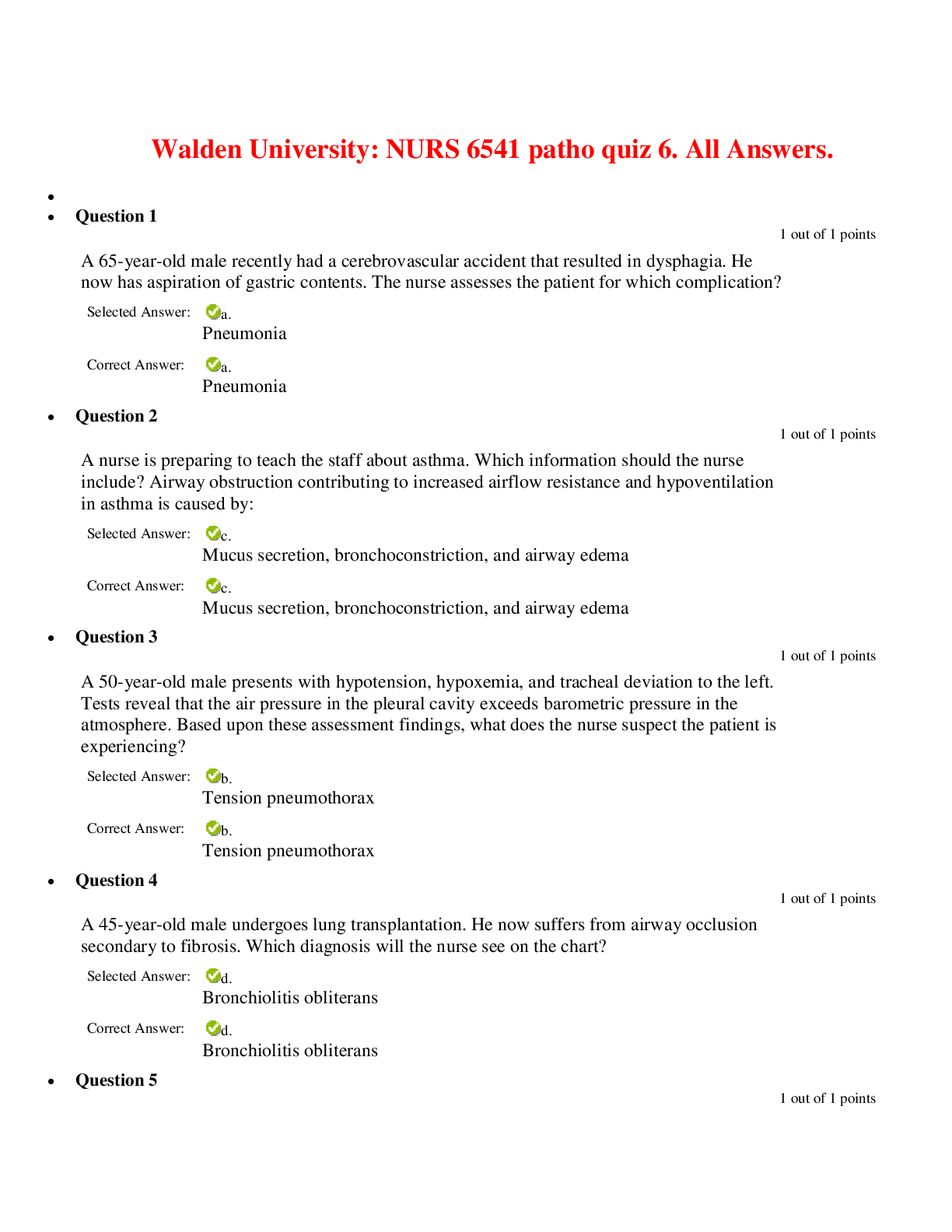





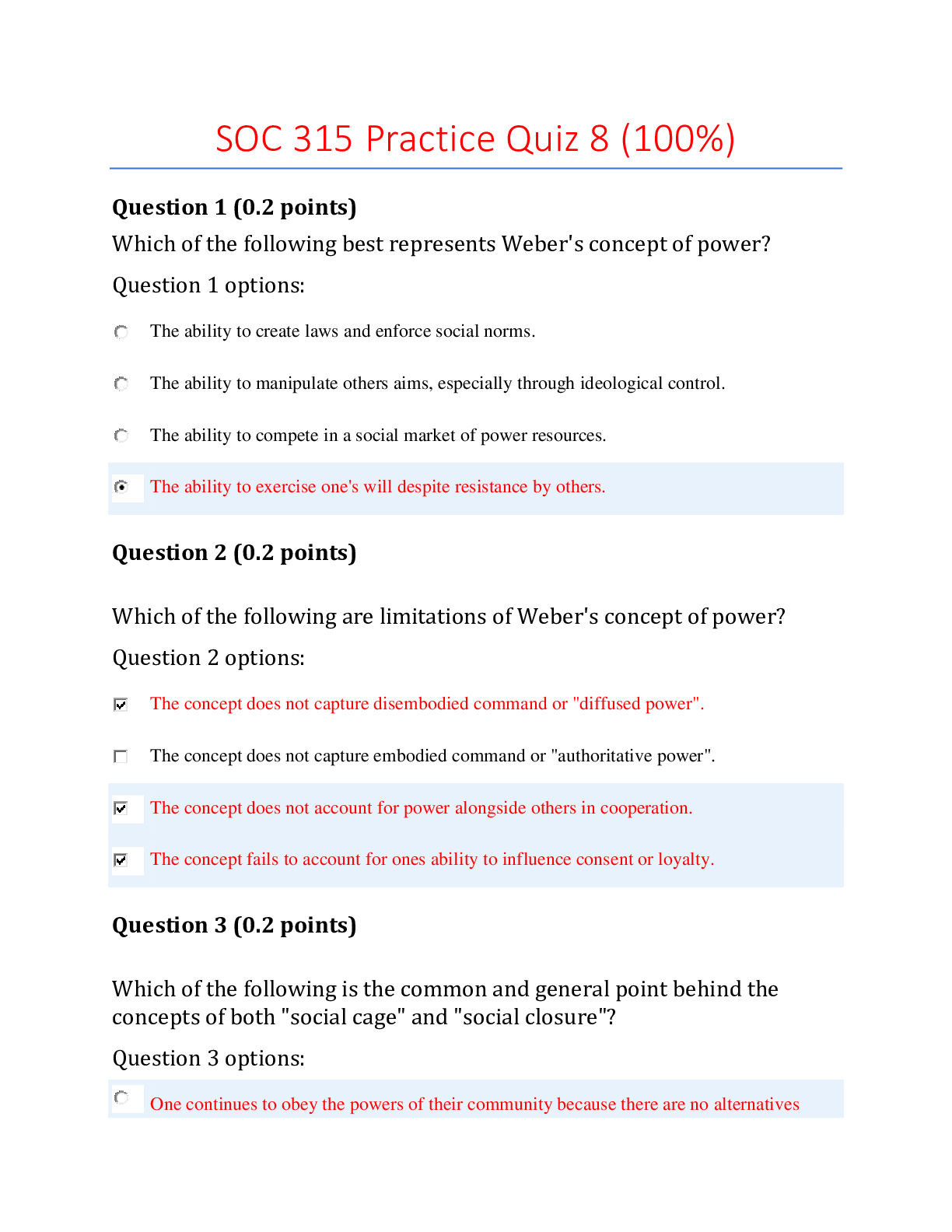
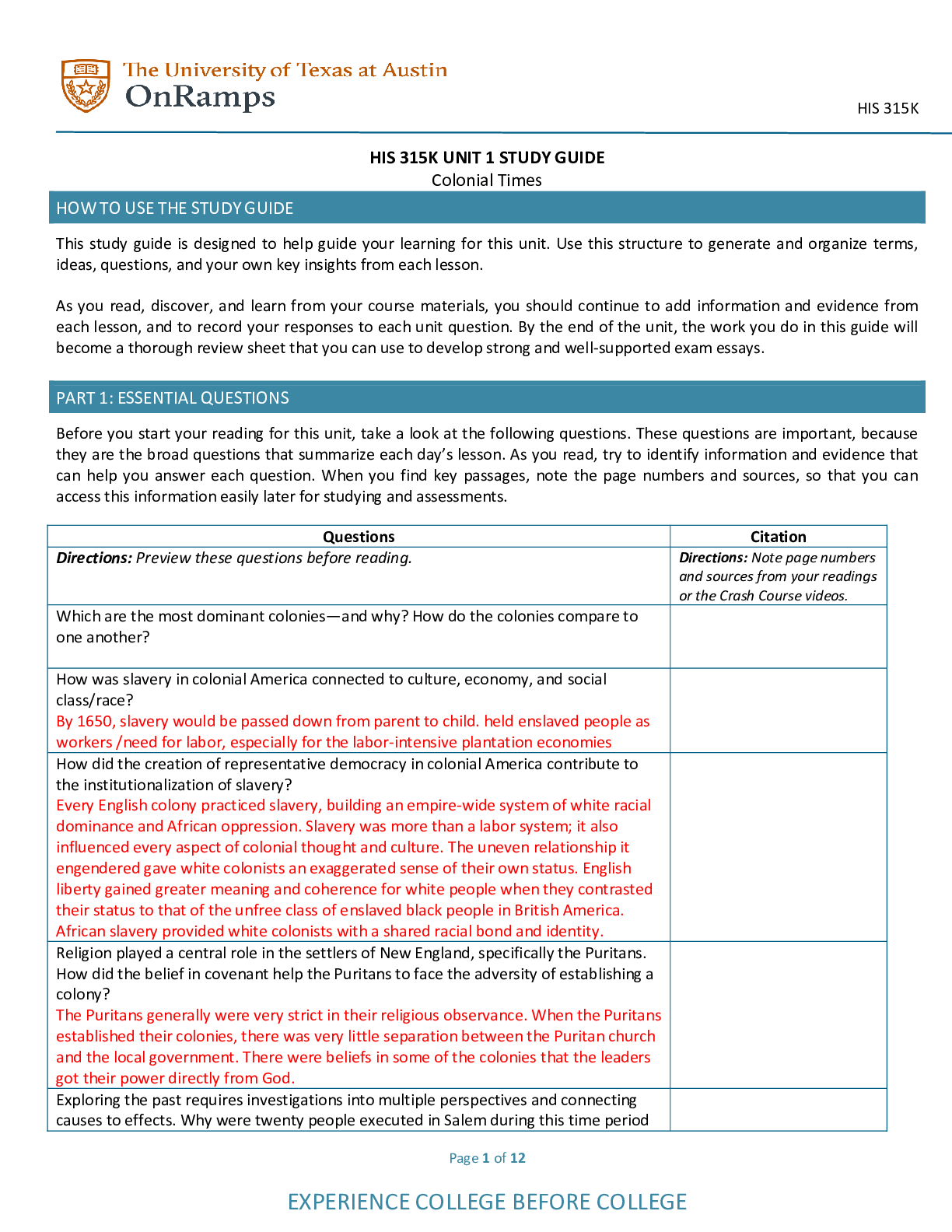
.png)

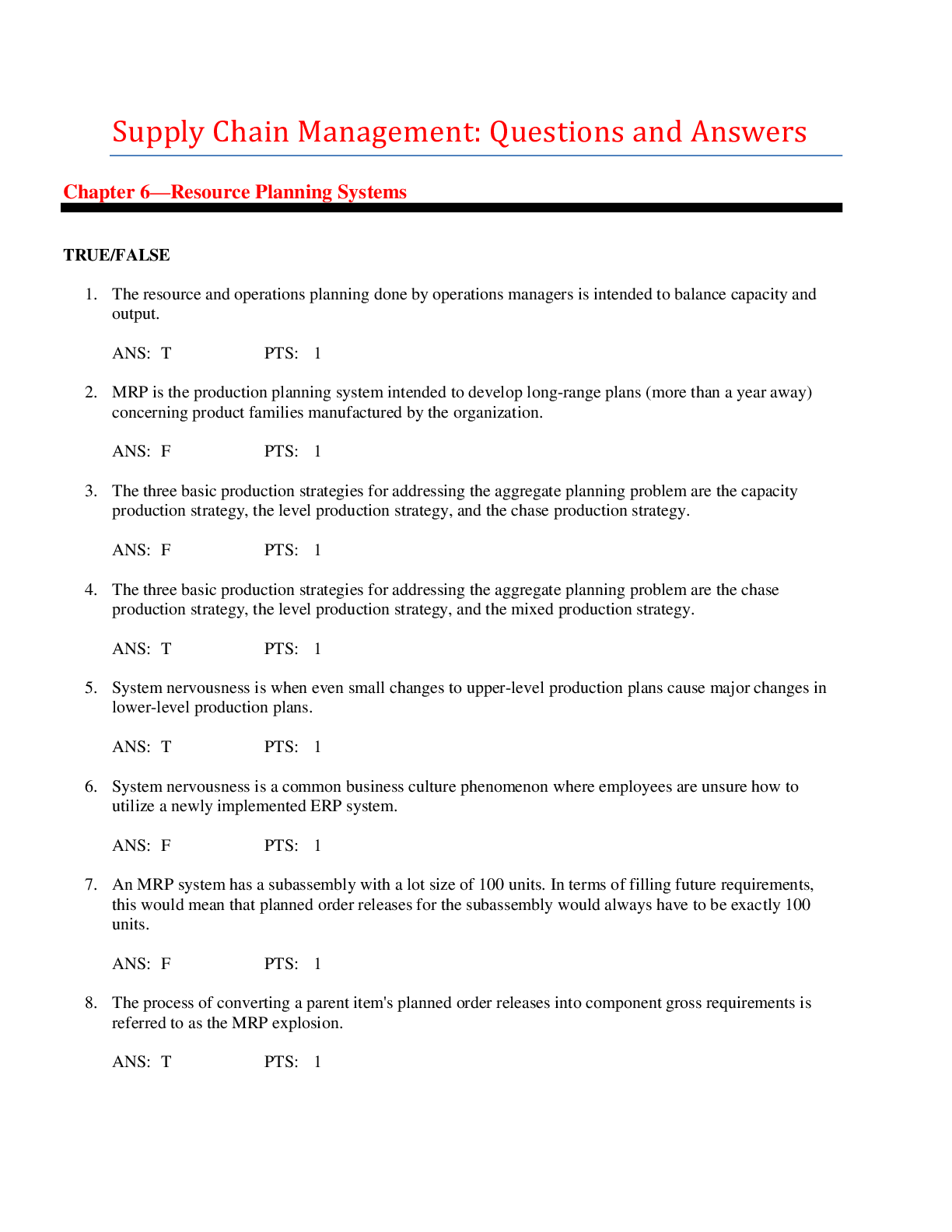
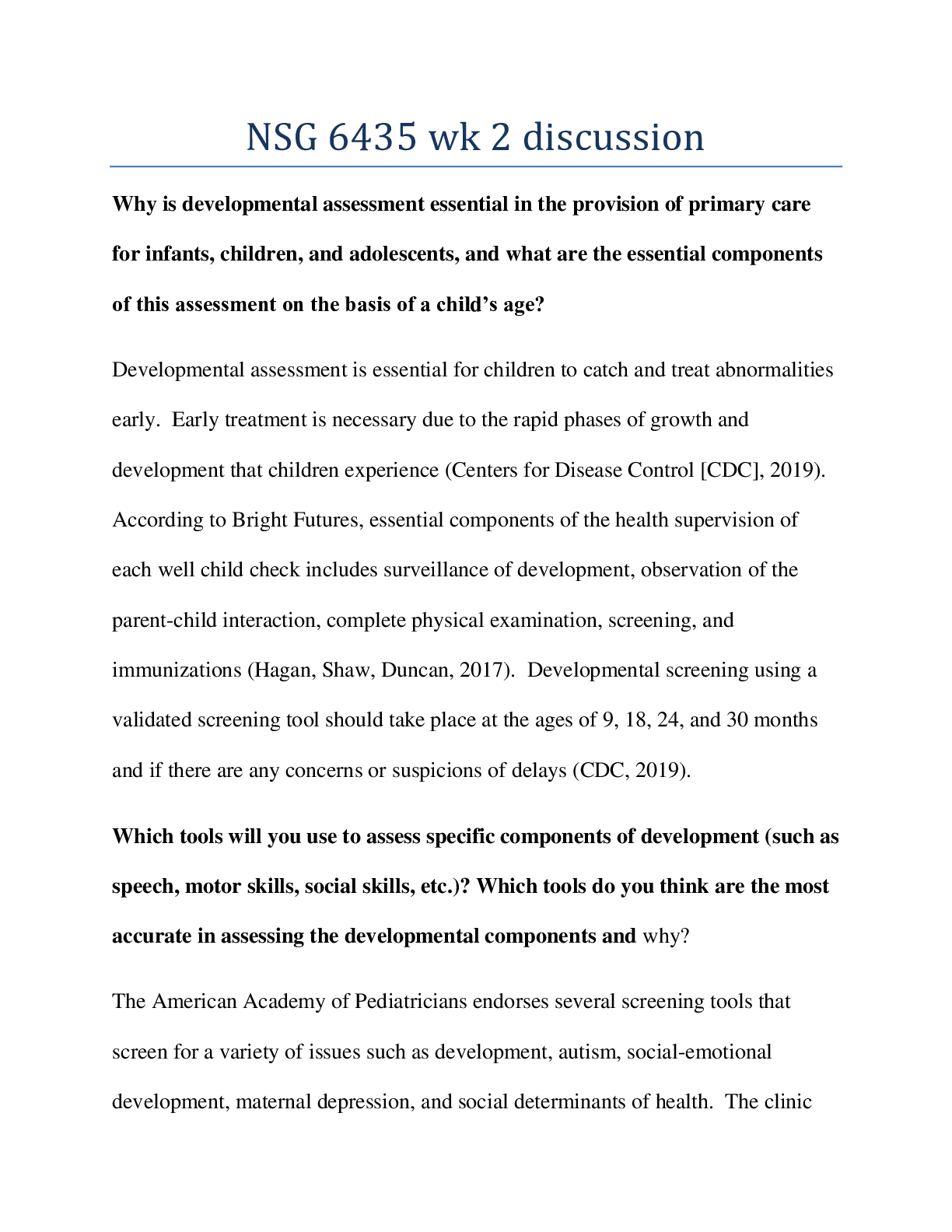

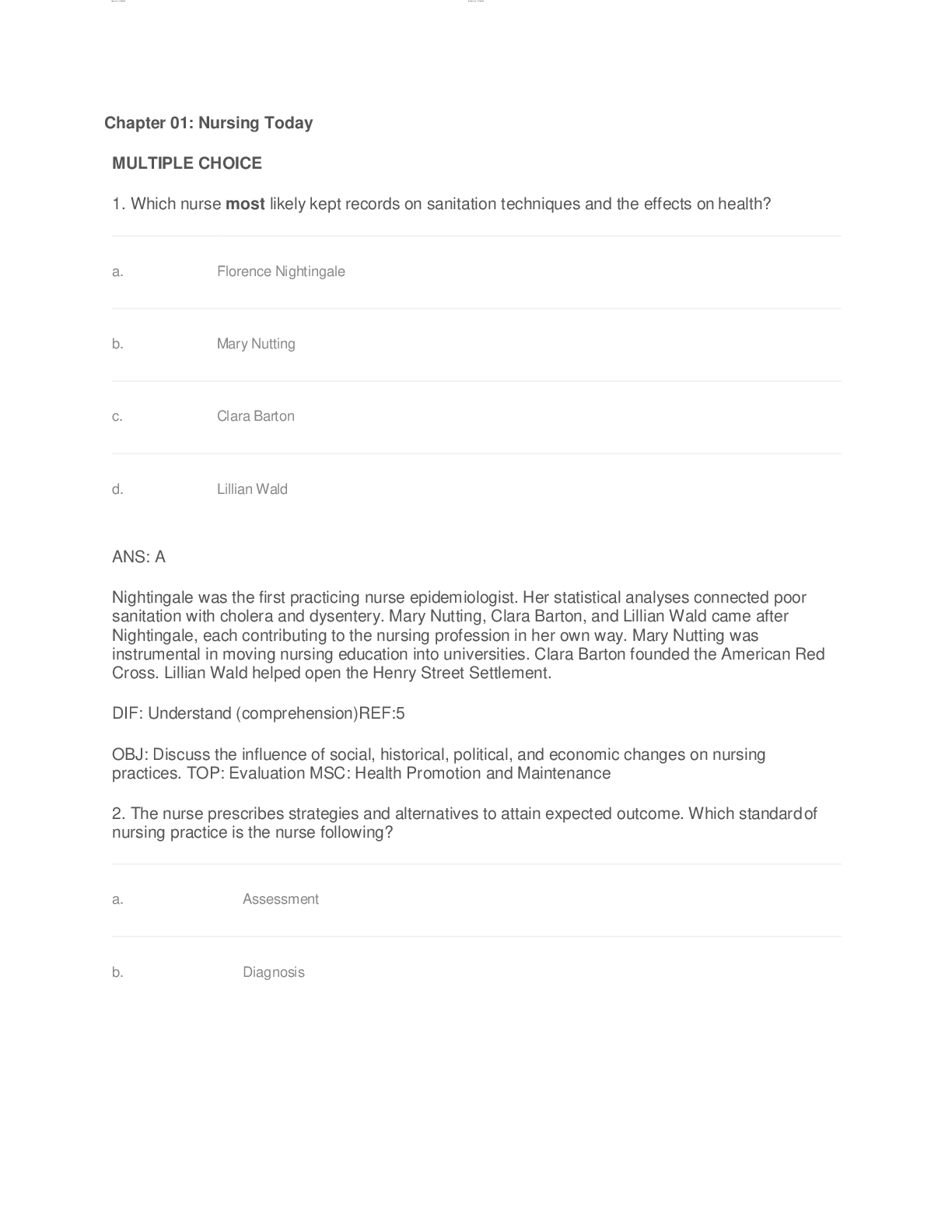
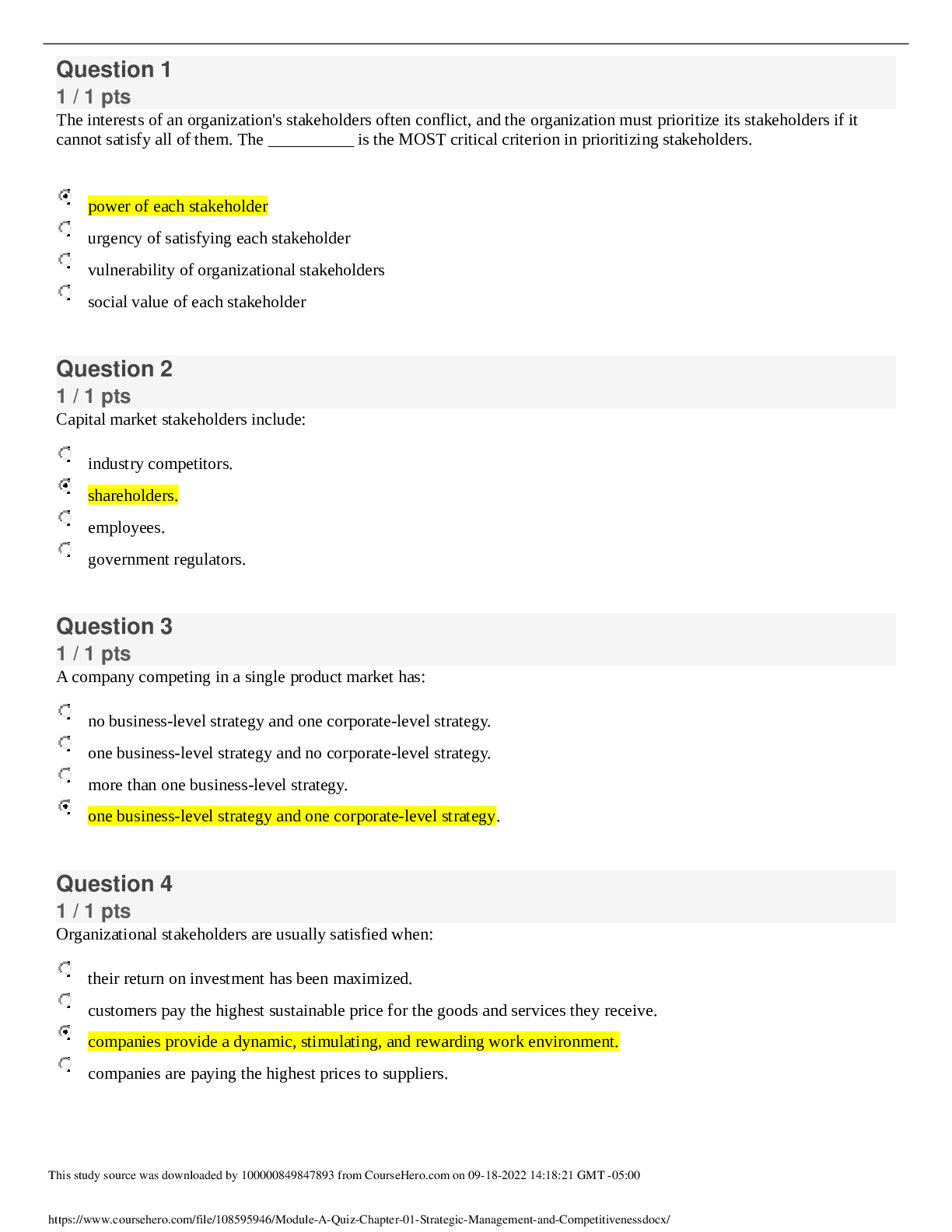



.png)

.png)

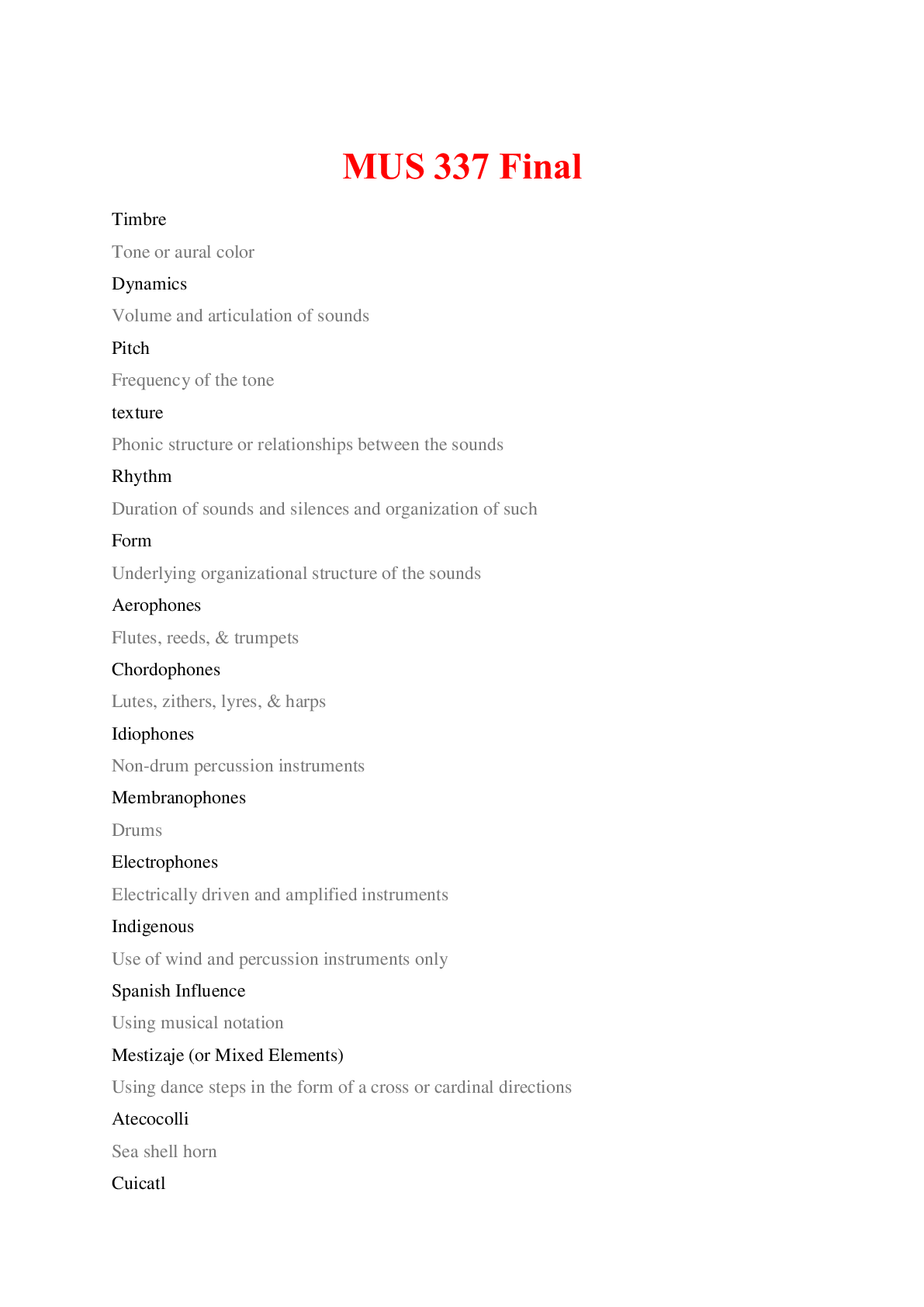

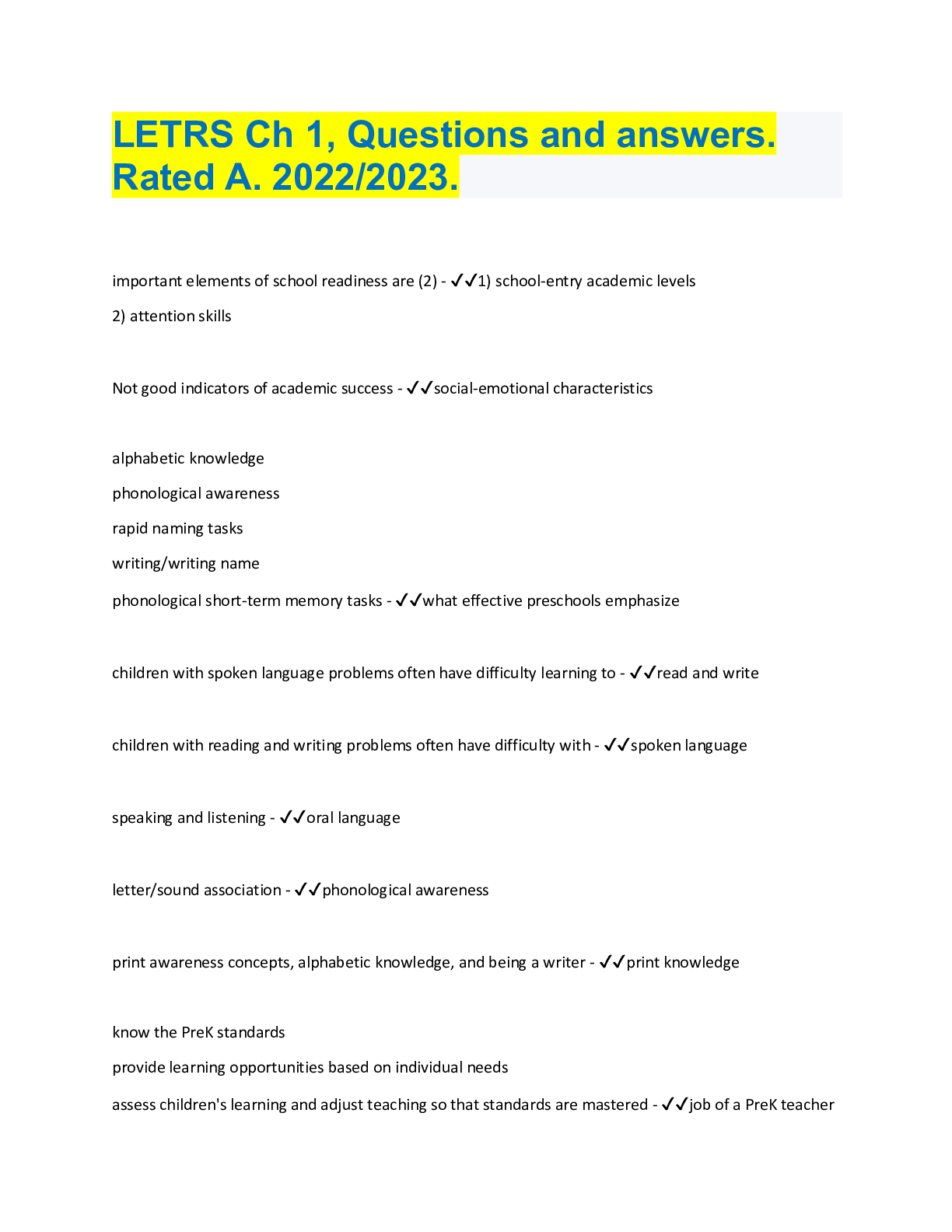
.png)
.png)

.png)
